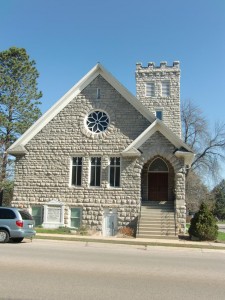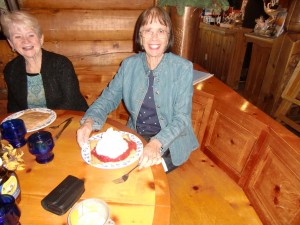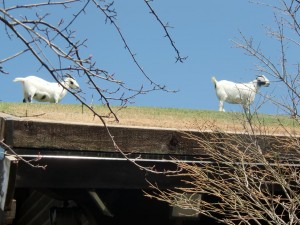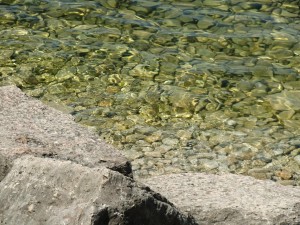TULIP TIME – WISCONSIN’S DOOR COUNTY
TULIP TIME
This is the eighth in a series of articles about seeing tulips and touring the state of Michigan
WISCONSIN’S DOOR COUNTY
By Charles N. Stevens
Photos by Dolores Seidman
In contrast to the gloomy skies of yesterday, this morning is clear and sunny, a perfect day to explore Wisconsin’s unusual Door County. We leave Green Bay and its Green Bay Packers and its Lambeau Field at mid-morning. Passing through an area of flat land, we again see many farms with old fashioned barns. We are told that barns are now so expensive to build that the hay is now wrapped tightly in plastic and left outside rather than being stored inside. We also pass a Georgia-Pacific paper mill with billows of steam rolling from its stacks.
A large sign reading “Welcome to Door County” greets us as we enter. Door County is most unusual as it juts out into Lake Michigan in a long narrow peninsula, like a large finger projecting from the bulk of Wisconsin. Green Bay, dark blue today, is on our left and Lake Michigan is on our right. Some of the barns we pass are “signed” with the mark of the builder, something I was never aware of before. I enjoy gazing at barns, farm houses and silos. Perhaps it is because my mother and father and all who came before them were farmers in Indiana. Maybe it‘s in my blood. We roll by acres of dark rich soil, green fields and dormant apple orchards. Tree farms are common, but wineries are rare. At Sturgeon Bay we come upon the Red Oak Winery and Vineyard that produces red and white wines as well as cherry and other fruit wines. I am amazed to find wineries this far north.
Sturgeon Bay is also noted for its facilities for the repairing of ships, particularly tankers that ply the lakes. And one other thing—a pastor in one of their churches composed the well-known hymn, “The Old Rugged Cross” one hundred years ago.
On we go, seeing more cut cornfields, marked barns and of all things, more wineries. The Door 44 Winery makes traditional wines, and the Door Peninsula Winery produces those as well as fruit wines, some odd ones like Chocolate Cherry wine and Midnight Berry. Not to my taste! More dormant cherry and apple orchards are common now.
We come to the small town of Fish Creek, gateway to beautiful Peninsula State Park on the shore of Green Bay. The park is so attractive that a million visitors a year come to see it and enjoy its beauty. It is also the largest state park in Wisconsin and contains forests, spectacular lake views, a sandy beach. limestone cliffs and hiking trails. It was a disappointment not to explore it rather than driving right by.
Nearby is the village of Ephraim, founded by the Moravian Church. It is the only dry municipality in the state of Wisconsin. We were told that they also do not allow dance halls. We pass a series of bays, Sister Bay and Ellison Bay, both scenic with hotels, condos, and the latter with a marble quarry. We pause near the ferry landing where one can take a trip to nearby Washington Island, an island settled by people from Iceland.
We stop for lunch at Al Johnston’s Restaurant in Sister Bay. This is a one of a kind restaurant that is hard to believe at first. The roof is sod with a thick green growth of grass growing on it. But even more unbelievable is that two goats are grazing on this grass. They nonchalantly nibble the grass, seemingly not caring that they are on a roof. The goats keep the roof trimmed so the grass never gets too long. The attractive restaurant serves basically Swedish food. Dolores has Swedish pancakes covered with strawberries and whipped cream while I have a Swedish meatball sandwich and a superb beet salad.
After lunch Dolores and I walk to a park that leads to the water’s edge. The water is so clear that we can see stones beneath the surface as though observing them through glass.
Shortly after, our bus leaves, heading back for Fish Creek. We walk around the resort village, enjoying the comparative warmth of the afternoon and wishing we could stay longer. But on we go. I notice the shadows of the trees on the forest floor all lying in one direction, an “artistic” sight. And then there are mown cornfields with their short stalks glistening in the sun, soon to be plowed under to enrich the soil.
We return to Green Bay and the same motel we stayed in the night before. After the chill of the day before, we enjoy a balmy 70 degree afternoon.

The church in Sturgeon Bay where the well-known hymn, "The Old Rugged Cross" was written.

Dolores at Al Johnson's restaurant about to dine on Swedish pancakes topped with strawberries and whipped cream.

The goats grazing on the sod roof of Al Johnson's Restaurant in Sister Bay.

The lake water is so clear that the stones can be seen clearly on the bottom.
MONTEREY PARK AUTHOR PUBLISHES 4th BOOK – Seeking More of the Sky: Growing Up in the 1930’s:
Charles “Norm” Stevens, a 43 year resident of Monterey Park has recently published his 4th book: Seeking More of the Sky: Growing Up in the 1930’s. This is the story of a young boy growing up in Inglewood, California in the l930’s. This was a time during the depression when unemployment was affecting many and the banks were closed, while the clouds of war were gathering in Europe. But he was lucky enough to be raised in a loving family, the power of that love reflected throughout his stories.
Stevens is the author of three previous books about his experiences during WWII:
An Innocent at Polebrook: A Memoir of an 8th Air Force Bombardier (Story of his 34 bombing missions from his base at Polebrook, England over Germany and France)
The Innocent Cadet: Becoming A World War II Bombardier (A prequel to the first, telling of his training in the U.S. before going overseas into combat.)
Back from Combat: A WWII Bombardier Faces His Military Future from Combat: (This book details the time from when he returned from combat in England until the end of the war.)
He is known to the readers of The Citizen’s Voice as the author of Travel Log Articles including “Cruising the Rhine and Mosel”,” Best of the West”, “In Search of Snow” , “From Paris to Normandy on the Seine”, and “Exploring New York”. He is retired, having taught for 32 years, primarily in the Montebello Unified School District.
Those interested in purchasing an autographed copy of any of his books, may contact the author at 323-721-8230 or Normstevens24@gmail.com.



